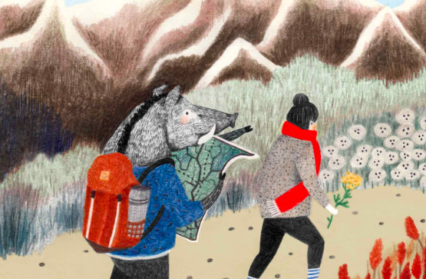Isobel Roach reviews Strange Animals by Emily Vanderploeg, a poetry collection charting a literal and emotional journey spanning issues of language, ritual, death and identity.
Canadian-born poet Emily Vanderploeg’s first full collection, Strange Animals, is a beautifully crafted rumination on identity, ancestry, and the environments that make us who we are. Beginning with a focus on journeys through nature – both real and spiritual – Vanderploeg’s form of poetic ‘Orienteering’ is a kind of divination. This is declared most strikingly in the collection’s opening poem; ‘I’ll trace creeks with the lines on my palm; tell fortunes of life amongst the bulrushes’. The first poetic sequence of the collections explores the ways in which we learn about ourselves amidst the brutal honesty of the natural world. To reflect on oneself is to look inward through the prism of nature – ‘I am thinking about my childhood’, Vanderploeg writes, ‘Or, maybe I am thinking about snow’. As we read through the subsequent stanzas of the poem ‘Whippoorwill’, we learn that there is no real distinction between these two subjects. Even the passage of time itself is ‘serpentine’, an ever-changing, snaking force of nature. Yet just as the world we live in has the power to forge our futures, so too are we capable of leaving our mark on the flora and fauna around us. In ‘Can you hear her whistling in the orchard?’, Vanderploeg disrupts the realm of the outdoors, ‘picking and praying’ with long grass. She describes ‘brambles picked clean’ and fruit halved and eaten so that she can ‘taste the meadow’s cool sweet hum’. All of this is enough to cause the trees to shiver, ‘not from the cold, but from the strength of my approach’.
Mirroring itself, Strange Animals ends with a sequence of poems centred around divination – this time imagined through the lens of tarot reading. Themes of fortune telling are taken up again, with an even more insular perspective as the poet asks the deck to expose her inner truths before recording them in the form of poetry. Vanderploeg’s journey to the past and questioning of the future is laid bare for the reader. ‘Now take off your mourning cloak and drink’, she commands herself, transforming from a passive sufferer of fate to an active agent for change who is ‘no longer reading the river but riding it’. Most interesting of all is the structure of this sequence. Vanderploeg presents her tarot poems on each page before also presenting them in a formation that reflects the layout of the cards according to the Celtic Cross reading spread. This makes for an exciting and memorable reading process, and one that is authentic to its spiritual subject matter.
Vanderploeg is both poet and cartographer, mapping out the landscape of her life and charting the trajectory of her ancestors’ migration from Hungary to Canada to Swansea. For Vanderploeg, map making is a means of recording her family tree, and language is as important as location in Strange Animals; in ‘On Christmas Eve’ the poet recounts her family’s seasonal traditions, interjecting with Hungarian, German, and Swedish words in her search for history and identity. Reflections on selfhood, place, and our true natures are not just limited to the human realm either; the collection’s eponymous sequence, ‘Strange Animals’, is a fascinating glimpse into the animal world that reveals an uncanny resemblance between man and beast. Dogs must reconcile their relationships with owners that keep them docile, carrying them down escalators, whilst still ‘expect[ing] it to retrieve the last stag killed’. A woodlouse crosses over the threshold into the domestic sphere and finds the placid warmth of this new environment lethal. In its last words it ponders its own ancient crustacean past; ‘I’ll just lie here a minute, put my feet up, think of my prehistoric ancestors fossilized in stone’. But there is a warmth to this animal world despite its strangeness, and Emily Vanderploeg writes of a kitten that ‘makes bruises on [her] palm that [she] endure[s] with the patience of a mother’s love’. In spite of the apparent incompatibility between animal wildness and human domesticity, mutual love is a powerful uniting force.
Nowhere is this more apparent than in Vanderploeg’s ‘Cupid and Psyche’ sequence. The poet presents an array of love poems, each filled with the syntax of desire, heartbreak, and optimism. Like every other subject in Strange Animals, romance is something that takes root in nature (‘Fevered kisses in fallow fields; this is where we will conceive our children’), yet Vanderploeg’s love poems are steeped in a distinctly contemporary digital culture. The mythical relationship of Cupid and Psyche is reimagined with a tongue-in-cheek social media twist; ‘she is wary and watchful, still loves the drama of it all when he lurks in the views of 24-hour stories’. There is loneliness in this superficial modern world, and forlorn lovers that leave the TV on ‘for company’ – but nature always finds a way, and Vanderploeg’s poetry is at its most touching when it offers its readers a glimpse of a resilient world in bloom. There is hope for both reader and author as the season’s shift;
‘I didn’t know the spring arrived at night.
I didn’t know my heart had been a ruby all along.’
Strange Animals by Emily Vanderploeg is available via Parthian Books.











